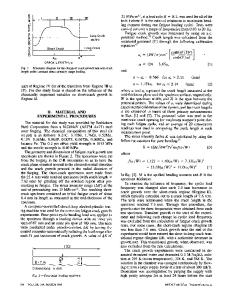Effects of sic content on fatigue crack growth in
- PDF / 3,349,676 Bytes
- 12 Pages / 597 x 774 pts Page_size
- 14 Downloads / 422 Views
I.
INTRODUCTION
C O M P A R E D to unreinforced metals and alloys, discontinuously reinforced metal-matrix composites offer superior strength, low density, and high stiffness, while maintaining their amenability to processing and characterization methods currently available for conventional metallic materials. These composites are, therefore, potential candidates for replacing conventional alloys in a variety of structural applications. The majority of recent research has placed emphasis on light metals, such as aluminum alloys, as matrix materials. Despite the recent surge in research interest on the mechanical response of discontinuously reinforced metal-matrix composites (e.g., References 1 through 10), relatively little information is available in the literature on the effects of thermomechanical processing (i.e., method of synthesis and aging treatments) and geometrical constitution (i.e., the volume fraction, size, shape, and distribution of the reinforcement phase) of the composites on the resistance to failure under cyclic loading conditions. Such information is essential for the design of structural components potentially made of metal-matrix composites which are inevitably subjected to fatigue loads in service. Y. SUGIMURA, Graduate Research Assistant, and S. SURESH, Professor, are with the Division of Engineering, Brown University, Providence, RI 02912. Manuscript submitted January 31, 1992. METALLURGICAL TRANSACTIONS A
Prior work (e.g., References 11 through 22) has shown that whether reinforcing a light alloy has beneficial or detrimental effects on fatigue response depends strongly on such factors as reinforcement content, processing methods, particle size and shape, and precipitation heat treatments. For example, in SiC whisker-reinforced aluminum-matrix composites, fatigue crack initiation can take up to 80 pct of the total fatigue life which is significantly in excess of the fatigue crack initiation life for the unreinforced matrix alloy. In unnotched fatigue specimens of metal-matrix composites, the mechanisms of cyclic deformation and fatigue failure can be as diverse as (a) progressive matrix damage (involving matrix slip and the roughening of the specimen surface by the formation of intrusions and extrusions), (b) progressive matrix failure by the nucleation, growth, and coalescence of voids around intermetallic inclusions in the matrix (primarily in systems in which the reinforcement phase has a good mechanical bond to the matrix), (c) debonding at the interfaces between the particles and the matrix, and (d) fracture of the reinforcement phase (see, e.g., References 17 and 18). Since the resistance to fatigue crack initiation and growth can exhibit different sensitivity to the microstructure, microstructural and geometrical factors which lead to a more beneficial fatigue crack growth response in the composite (as compared to the matrix alloy) can in fact promote an inferior crack initiation life. Furthermore, since the extent of VOLUME 23A, AUGUST 1992--2231
plasticity and geometric const
Data Loading...










